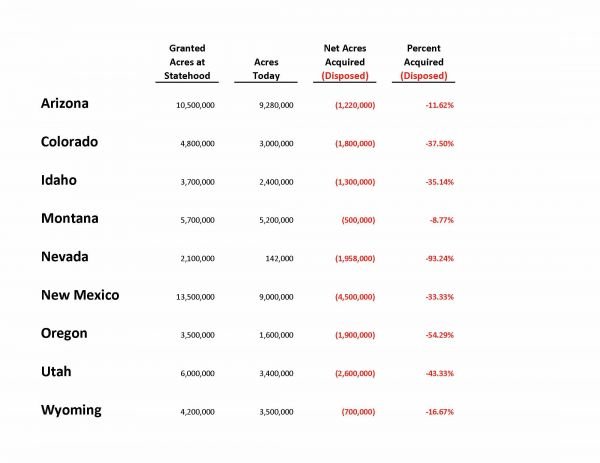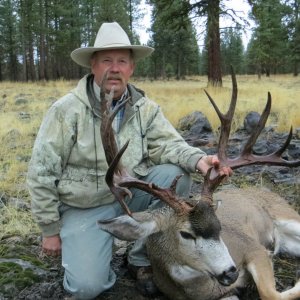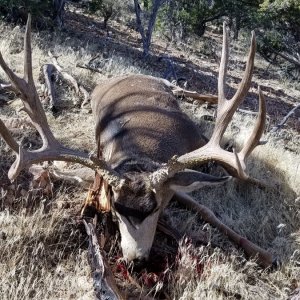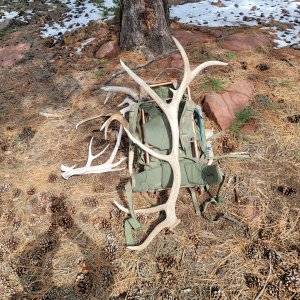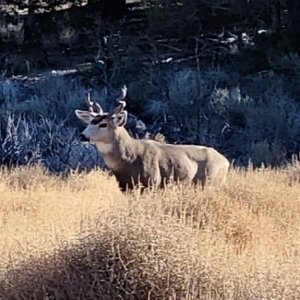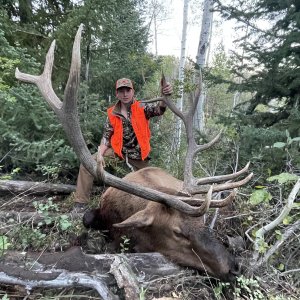>>It is well-sourced and gives actual fact-based information with links to the sources so we can see for ourselves.
*******
From the article:
In the past 110 years, 16 presidents, (eight Democrats and eight Republicans) have used the power of the Antiquities Act to designate 126 national monuments, ranging from Calvin Coolidge?s designation of the 320-square-foot Father Millett Cross, in Youngstown, N.Y., to the 140,000-square-mile Papahānaumokuākea Marine National Monument designated by George W. Bush. The first national monument, established by President Theodore Roosevelt, was Devil?s Tower, in Wyoming. Barack Obama has used the Act a record 29 times.
*******
Considering his bias, it's not surprising he didn't include one other number above: the 30 or so national monuments that are now national parks.
He opened his article by fondly recalling his quail hunt on a monument in New Mexico. I also recall once being able to hunt quail, deer and javelina on what became the Saguaro National Monument. Today, it is Saguaro National Park, with a ban on hunting.
So...in the interest of getting ALL THE FACTS here, rather than simple posting the link, I'll post the entire article by historian Robert Righter. Yeah, it's a long read, but it lays out the "facts" quite well.
*******
National Monuments to National Parks:
The Use of the Antiquities Act of 1906
ROBERT W. RIGHTER
In the heat of the 1932 battle to enlarge Grand Teton National Park, conservationist ##### Winger mused that "it would he nice if President Hoover would decide to make the territory embraced in the Jackson Hole Plan into a National Monument." [1] Winger, as well as other advocates, was frustrated by a slow, fickle Congress, which was reluctant to pass a park bill. Exhausting discussion, debate, letter writing, and congressional investigations had netted nothing. Quick presidential action could accomplish what park proponents desired. Eleven years later, in 1943, Winger obtained his wish?President Franklin Roosevelt established Jackson Hole National Monument. An expanded park, which could not be accomplished through the congressional process, came into being through executive fiat.
The case of Grand Teton National Park was not unique. National parks such as Grand Canyon, Bryce, Zion, Acadia (Maine), Olympic, and many others, were first created as national monuments. The reasons that these parks began as monuments varied, but surely a primary cause was political?one sympathetic president was easier to deal with than a hesitant Congress. Why not seek rapid presidential action rather than dilly dally with a tortoise-paced Congress?
The realization that the creation of national parks had more to do with presidential rather than congressional action calls into question the democratic origins of the national parks. Although there is no question that parks, properly understood, were established for the people, whether they were established by the people is another matter altogether. Pork-barrel politics created some; philanthropists intent on doing good work created others. And, of course, Congress created many. The objective of this essay, however, is to review the president's power in park-making through use of the Antiquities Act. By law, of course, Congress creates national parks. However, when Congress was tight-fisted, belligerent, or, more likely, lethargic, park proponents pulled the rabbit of the Antiquities Act out of the hat. Quite simply, under this 1906 act the president could set aside, by executive decree, areas as national monuments. Throughout the twentieth century zealous park proponents, as well as the National Park Service itself, were quite willing to circumvent the powers of Congress by appealing directly to the chief executive. Later, when the time became more propitious, the monument would be "upgraded" to a national park. [2]
The origins of the Antiquities Act of 1906 provide an understanding of this "back door" method of establishing national parks. Professional archeologists were the prime movers. Government officials assisted. The problem was vandalism on Southwest Indian archeological sites and the helplessness of federal officials to prevent it. The concern, however, was also with Congress. By the turn of the century the General Land Office, headed by Commissioner William A. Richards, recognized the urgent need to give protection to such important sites as the Petrified Forest and the Cliff Dwellers' region of Frijoles Canyon in New Mexico. Congress did not seem to share this concern. Specific legislation for specific sites failed, leaving Richards and the archeological community with the impression that hope for congressional action was futile. In 1904 Richards wrote the secretary of the interior: "What is needed is a general enactment, empowering the President to set apart, as national parks, all tracts of public land which . . . it is desirable to protect and utilize in the interest of the public." [3]
Commissioner Richards understood what needed to be done, and he also recognized how it could be done. As an ex-governor of Wyoming, he understood the power of the executive branch. Disappointed by Congress, he was anxious to invest power in the presidency. He was not alone; a growing circle of archeologists were also committed to action: Furthermore, Progressive conservationists such as Gifford Pinchot and Frederick Newell looked to a vigorous president to carry out their goals. Such professional men did not believe that debates over resource use should be carried on in Congress, a body prone to partisanship and political logrolling. Resource policies should be shaped by scientists and engineers, not politicians. Conservation historian Samuel Hays has argued forcefully that the conflict between Theodore Roosevelt and Congress over resource policy caused much discord. Eventually Roosevelt came to the opinion that the executive was the 'steward' of the public interest. Feeling that he, rather than Congress, voiced most accurately the popular will, he advocated direct as opposed to representative government." [4]
Such a political ideology was most evident in Roosevelt's vigorous use of the Forest Reserve Act of 1891. When Roosevelt came to power some forty-one forest reserves encompassed some forty-six million acres. In 1907, caught in political cross fire, Roosevelt signed away his executive privilege. But by then the system contained 159 forest reserves totaling over 150 million acres. [5] Certainly the vigorous leadership of Gifford Pinchot partially explains this avalanche of national forests, but there was no denying that executive decree could accomplish conservation objectives quickly and without devisive debate. National park advocates were envious. While Presidents Harrison, Cleveland, McKinley, and Roosevelt had created 159 national forests, during the same period Congress had authorized eleven national parks, and then only after years of promotion effort. [6] Given such evidence, it is not surprising that when the Antiquities Act was drafted it contained the privilege of executive decree to set aside "historic landmarks, historic and prehistoric structures, and other objects of historic or scientific interest" as national monuments. [7]
Congress, of course, did not relinquish its powers without debate. In the hearings over various versions of the Antiquities Act, legislators voiced considerable concern over the president's power. The majority of lawmakers agreed with the need for protection of Southwest prehistoric sites, but the idea of extending carte blanche to the executive branch worried some, particularly western congressmen. One way to reduce the chance for misuse was to limit the size of national monuments. Congressman John Shaforth of Colorado argued for a maximum of 320 acres, while his influential state colleague, Senator Henry M. Teller, was willing to extend monument size to a section, or 640 acres. Both Colorado congressmen were sympathetic to livestock interests and had experienced the "excesses" of the Forest Reserve Act in their state. [8] Although Teller's request received consideration when the final Antiquities Act emerged it read that national monuments "shall be confined to the smallest area compatible with proper care and management of the objects to be protected." [9]
Of course, such loose language left loopholes which even the portly William Howard Taft could slip through. Perhaps the broadest interpretation of this size limitation was President Jimmy Carter's declaration of seventeen Alaskan national monuments in 1978, totaling some 56,000,000 acres?certainly not what the critics or the framers of the Antiquities Act had in mind. [10]
What did the sponsors of the Antiquities Act envision? They agreed that national monuments would be small in area and geographically confined to the American Southwest. In fact, when Representative John Hall Stephens of Texas expressed his fear that the president might use the proposed act as Roosevelt had used the Forest Reserve Act, sponsor John Lacey assured his colleague that the two acts were entirely different, and that the act would simply be used to preserve "Indian remains on the pueblos in the Southwest. . . ." [11] After the bill become law (8 June 1906) its limited scope was emphasized by Edgar Hewett and Charles Lummis, both prominent in the Archaeological Institute of America, when they wrote President Roosevelt that "the purpose of this act is absolutely plain. It is an Act for the Preservation of American Antiquities. It provides for the preservation of conspicuous ruins, as national monuments, and for the preservation of material buried in the soil by excavation and installation in public museums. The law is perfectly simple and satisfactory to every body." [12]
If Congress had effectively limited the size and the location of monuments, there would be no story to tell. However, the president's hands were not tied in either category. The Antiquities Act of 1906 proved to be loosely written, and instead of the narrow archeological application envisioned by Hewett and Lummis, it was applied by enterprising presidents and park proponents at a broad range of sites and in such situations which might well have amazed sponsor John Lacey. In the constant tug-of-war between president and Congress, the act became a significant executive tool to shape sometimes controversial conservation policies.
From the beginning, it was evident that use of the act would not be geographically limited. Devil's Tower in eastern Wyoming was the first monument which Roosevelt established, disregarding the Southwest orientation of the act. The next four?Petrified Forest and Montezuma Castle in Arizona, and El Morro and Chaco Canyon in New Mexico?were certainly expected and within the intent of the act. Lassen Peak and Cinder Cone National Monuments, both established on 6 May 1907, represented a departure in that they were the first monuments which would be incorporated soon into a national park (Lassen Volcanic National Park, 16 August 1916). [13]
However, the establishment of Grand Canyon National Monument on 11 January 1908, was the first example of creating a monument in lieu of a park. Certainly the Grand Canyon possessed the quality and grandeur of a national park. It was first considered for national park status in 1882, when Benjamin Harrison, then a senator from Indiana, introduced a bill which failed. Twice more in the 1880s the Congress rejected park bills. Just why these bills died is not clear. Perhaps congressional leaders did not wish to expand a park system which was then limited to Yellowstone. More to the point, some opposition existed. Local businessmen failed to realize the value of a park, and mining interests wanted no barriers to mineral exploration of the canyon. Consequently, jurisdiction of the Grand Canyon underwent a strange bureaucratic metamorphosis which can only be explained in political terms.
Some protection was needed, and President Benjamin Harrison provided it. On 20 February 1893 he proclaimed Grand Canyon Forest Reserve, withdrawing the area from homestead entry. That much of the forest reserve was barren of trees did not disturb him. The irony did not escape local residents, however. They submitted a protest petition, which argued that the Grand Canyon was "strictly mineral country." [14] Clearly, the Harrison reserve proclamation was a holding action, and throughout the 1890s proponents attempted to achieve national park status. However, the opposition remained. Perhaps the Arizona newspaper Williams Sun represented a radical fringe, but surely it titillated many of its readers when it editorialized that the national park idea represented a "fiendish and diabolical scheme," and that whoever fathered such an idea must have been "suckled by a sow and raised by an idiot." "The fate of Arizona depends exclusively upon the development of her mineral resources," proclaimed the tabloid. [15]
Local opposition paralyzed congressional action. Protection from exploitation would have to come from the presidency. In June 1906, Theodore Roosevelt created Grand Canyon National Game Preserve. The preserve prevented hunting, trapping, killing, or capturing of game animals. Otherwise, it accomplished little. The Antiquities Act armed Roosevelt with a more potent protectionist weapon, and in January 1908, Executive Order 794 proclaimed Grand Canyon National Monument as "an object of unusual scientific interest, being the greatest eroded canyon within the United States." The monument, located within Grand Canyon National Forest, would continue to be administered by the United States Forest Service. [16]
Although President Roosevelt had done his best to protect Grand Canyon, conservationists were not pleased with either the monument status or Forest Service control. The agency itself recognized that it was more adept at managing trees than tourists. By 1914 "people problems" caused Chief Forester Henry Graves to admit that his bureau was not prepared to impose "the close supervision over the movements and actions of individuals which is the practice in the National Parks." [17]
Many in the private sector agreed with Graves. Perhaps the editor of the Saturday Evening Post was among the most strident when he wrote that the monument designation was really "a monument to our national ignorance and apathy, our national dilatoriness and shiftlessness." In his view, the Forest Service stood for "utility only," while the favored Park Service had "to do with beauty only." [18] Although more reserved, Secretary of the Interior Franklin Lane contended that Grand Canyon could "not, as a section of two national forests, a game refuge, or a national monument, be properly developed . . . effectively administered or adequately protected." [19] Congress could no longer resist, and in 1919 a bill establishing Grand Canyon National Park passed, thus ending the monument phase as well as Forest Service jurisdiction.
However, the curious liaison between Grand Canyon and the Antiquities Act was not over. On 22 December 1932, President Herbert Hoover established a new Grand Canyon National Monument. From 1927 on, the Park Service wished to expand the park with what it called the "Toroweap Addition to Grand Canyon National Park." However, when it came time for action, park service officials pushed for a national monument rather than a national park addition. [20] The officials reasoned that executive action would be more secret and thus prevent land inflation. They also hoped to avoid congressional debate and roadblocks. Hoover's proclamation presented the opponents with a fait accompli, and the best local ranchers?concerned about the loss of grazing lands?could do was sign a petition questioning the circumvention of representative democracy. "We the tax payers feel that a law to make this land a National Park," the petition read, "would never have passed Congress, that President Hoover knew this and so took unfair advantage of his position and made this a National Monument." [21]
The final use of the Antiquities Act in Grand Canyon came some thirty-seven years later when President Lyndon Baines Johnson proclaimed the Marble Canyon National Monument, adjacent and upriver from the Grand Canyon. True to course, the new monument was incorporated into Grand Canyon National Park in 1975. Some sixty-five years of Antiquities Act manipulation resulted in the park as it exists today.
One hundred miles north of the Grand Canyon, as the crow flies, lies another remarkable canyon through which flows the Virgin River. Zion National Park provides not only a parallel in the nature of its scenery, but in the method of its establishment. Like Grand Canyon National Park, all of the land within Zion was set aside under authority of the Antiquities Act. The first step was taken by William Howard Taft, when he proclaimed Mukuntuweap National Monument in 1909. At that time the sculpted valley was as obscure as the name, isolated and unknown. The second step occurred in 1918 when Woodrow Wilson enlarged the monument acreage five-fold (15,840 to 76,800 acres) and changed the name to Zion.
Assistant Director of the National Park Service Horace Albright, Utah Senator Reed Smoot, local people, and representatives of the Union Pacific Railroad all wanted a national park. The reasons most often cited were protection and development for tourism. A park was necessary, argued one government report, to give "protection, improvement and control that can only be obtained with a resident force of park employees." [22] Why such a force was unavailable under monument status went unexplained. The reason was money. Horace Albright made this clear in writing to Senator Smoot on the subject of Zion Canyon in 1917, noting that the appropriation bill asked for $5,000 for twenty-one monuments, thus "the amount that will be available for any one monument will be very small indeed." [23] If Senator Smoot had been wavering on the need for park status, Albright's news that the monument would receive probably about $238 for fiscal year 1918 surely convinced him! To a wider audience, Secretary of the Interior Franklin Lane reiterated the same message when he stated that Zion "is proposed as a national park, and as soon as this is accomplished certain extensive improvements should be made." [24] No explanation was given as to why monuments received meager appropriations and were ineligible for development.
Zion became a national park in 1919, but additions to the park would again involve the Antiquities Act. In 1930 Zion National Park Superintendent E. T. Scoyen became enamored with Kolob Canyon, adjacent to Zion and quite magnificent in scale and beautiful in coloring. He wrote Director Horace Albright proposing that Kolob be proclaimed a national monument. Scoyen rejected the idea of an addition to Zion National Park, stating that he could "see no reason why we should wait for opposition to develop before this bill is sent to Congress. A clever agitator can stir the people on these lands to open warfare on the subject, and do harm to both the Park and the people themselves in the end." Albright's response was to send Roger Toll, his trusted representative in the West, to report on the proposed Kolob Canyon National Monument. After a three-day horse pack trip in October 1932, Toll wrote his report extolling the beauty of the canyon and emphasizing that it was of "park quality." Toll recommended that Kolob should "be an addition to Zion and not as a separately administered area." However, the alert envoy did not suggest a national park addition. "For practical considerations it might be that the area would be first established as a national monument, with the expectation of eventually adding it to Zion by act of Congress." [25] Specifically, Toll and others wished to avoid a fight in Congress with the grazing interests. Often, the anticipation of opposition was enough reason to press for a national monument.
One question that Toll failed to address was whether Kolob Canyon qualified for monument status under the Antiquities Act. His report stressed scenic beauty and wilderness quality, with not one sentence devoted to scientific or historic importance. Clearly, for Toll the Antiquities Act was not a consideration when he submitted his report. Monument status was a convenient stepping stone, a "halfway house" on the road to what National Park Service Director Stephen Mather often called "parkhood."
In 1937 President Franklin Roosevelt proclaimed Kolob Canyon as the second Zion National Monument. This one had a longer life span than the first, existing until 1956, when it was made part of the park through an act of Congress. [26]
Not all monuments were the result of a desire to bypass Congress. Some resulted from the political manipulations of the Forest Service and the National Park Service: two federal agencies in competition to parcel out the unspoken-for mountain terrain of America. As Forest Service Chief Henry Graves confided to his diary in 1916: "There seems to be continuous trouble over the national parks." [27] The newly-established Park Service aggressively sought to carve new national parks from Forest Service lands, and sometimes the Antiquities Act was interjected into their departmental quarrels. There are other examples, but the case of Bryce Canyon National Park illustrates the point. President Theodore Roosevelt incorporated the spectacular U-shaped canyon of hundreds of eroded sandstone spires and minerals into Powell National Forest in 1908. In the years to follow, Forest Supervisor J. W. Humphrey publicized the beauty of the canyon, but when Park Service Director Stephen Mather viewed the "jewel-like little amphitheater" in 1919 there was no doubt that the Forest Service faced a formidable jurisdictional foe. [28]
With a certain air of innocence the Park Service recommended national monument status for the canyon, and Utah Senator Reed Smoot embraced the idea. In a 1922 meeting in Smoot's office, the senator, Utah Representative Donald Colton, the commissioner of the General Land Office, and representatives of the National Park Service and the Forest Service hammered out an understanding. They agreed to add 2,320 acres of land to Powell National Forest while simultaneously creating this acreage as Bryce Canyon National Monument, under the jurisdiction of the Forest Service. Secretary of the Interior Albert Fall supported this plan, writing Agricultural Secretary Henry Wallace that he would "cheerfully join in recommending such a course." [29] President Calvin Coolidge declared Bryce Canyon National Monument in June 1923. Nonetheless, Forest Service control was short-lived. The following year a bill creating Utah National Park passed (to be changed to Bryce Canyon National Park in 1928), and Forest Service control ended. [30] Impermanent national monuments well served the desires of Stephen Mather and Horace Albright to showcase southwest Utah's scenic beauty as part of the national park system.
Use of the Antiquities Act was not limited to the American West. The first national park in the East, Acadia National Park on the coast of Maine, underwent a familiar metamorphosis when park benefactor George B. Dorr took the idea to Washington. Dorr was advised that the legislators were unresponsive to park proposals and that he ought to "forget Congress and address himself instead to the President. . . ." [31] Woodrow Wilson did not disappoint him. Sieur de Monts National Monument was proclaimed in July 1916. By 1918 Director Stephen Mather reported that the monument "seems now well started on its way to national parkhood . . . where it rightfully belongs." [32] It was "elevated," to use Mather's verb, to Lafayette National Park in 1919, and the name designated Acadia in 1929.
In the Pacific Northwest, a similar bureaucratic evolution took place. Conservation interest in the Olympic Peninsula first resulted in President Grover Cleveland setting aside the 2,188,800 acre Olympic Forest Reserve in 1897. Protests from the logging industry prompted President William McKinley to withdraw some 721,860 acres from the reserve in 1901. With Roosevelt as president, conservationists pushed for a national park. Of particular concern was the survival of the Olympic or Roosevelt Elk herd, named in 1897 by the naturalist C. Hart Merriam for Theodore Roosevelt. [33] Whether Merriam's stratagem influenced Roosevelt is not certain, but we do know that Roosevelt was determined to increase federal protection. His 1909 proclamation, signed some forty-eight hours before Roosevelt left office, established the 610,560 acre Mount Olympus National Monument. This action represents the first "lame duck" monument. It would not be the last.
Again, Roosevelt surely stretched the meaning of the Antiquities Act to the limit. The Olympic monument was a place of natural beauty. Scientific, archeological, or historical values were either secondary or nonexistent. The primary purpose cited by the executive decree was to provide a refuge for Roosevelt elk but, as historian John Ise points out, "the monument was not closed to hunting or trapping until October 5, 1927, by President Coolidge." [34] One can only agree that "under any other interpretation of the Antiquities Act other than Roosevelt's own, the Mount Olympus National Monument would have remained a part of Olympic National Forest." [35]
The administrative history of the Olympic Mountains between the establishment of the monument and the creation of Olympic National Park in 1938 is complex, centered on mining hopes and lumbering realities, state concerns, political manipulations, and the conflicting conservation ideologies of the Park Service and the Forest Service. [36] From its establishment until 1933 the Forest Service administered the monument. With pressure from logging interests and Forest Service agreement, the monument was halved in acreage by a proclamation signed by President Woodrow Wilson. When the Park Service assumed jurisdiction of all the national monuments in 1933 the Washington office was besieged with inquiries as to what would be done with Mount Olympus National Monument. Replying to conservationist Irving Clark, Director Arno Cammerer discussed the Park Service's approach to the park versus monument question:
One of the main problems before us relating to the Mount Olympus area is whether or not it should be made a national park rather than retained as a national monument. If the area is superlative in every respect, is sufficiently significant, and is particularly usable as a place to visit, its status should be changed to that of a national park. If, on the other hand, it is an area that should be given special protection and carefully preserved from wide use, then its status should remain as at present. [37]
Clearly Cammerer's interpretation rested on his agency's recent treatment of monuments rather than the Antiquities Act. If Olympic was worthy of development, then park status was in order. However, if it was to be "carefully preserved from wide use" and essentially managed as a wilderness area, then monument status should continue.
As the Olympic debate developed it was evident that none of the interest groups favored continuation of the monument. Those who stood for development wished the land returned to the Forest Service, whereas those who fought for preservation demanded that the monument be replaced by a national park. A few mavericks, such as C. Parker Paul of the Dartmouth Outing Club, favored retention of the monument to guarantee preservation of "this wilderness sanctuary . . . just as nature left it." [38]
Although Paul expressed the views of a miniscule minority, his misunderstanding of the nature of national monuments certainly represented the majority. Few persons understood the connection of monuments with the Antiquities Act. Monuments, as often defined by the National Park Service, were undeveloped parks. Monuments were consistently subject to starvation budgets which precluded development. Needless to say, park advocates won out, and in 1938 Olympic National Park replaced the old monument: a monument that had never been much more than a holding action until a satisfactory settlement could be reached.
The term "holding action" is most appropriate in describing national monuments in the 1920s and 1930s. The duration of national monuments was often short, and their definition was hazy at best, and nondescript at worst. Official National Park Service policy called for the "upgrading" of national monuments to national park status. One might legitimately ask, "What was the difference?" The question could be answered in a variety of ways?none satisfactory?but certainly national parks were well funded, and national monuments were not. This had nothing to do with congressional law, but rather with bureaucratic preference and public popularity. Under the leadership of Stephen Mather and Horace Albright the national parks were considered the "crown jewels" of the system, thus entitling them to generous appropriations. National monuments, on the other hand, were expected to survive with little, and often no, appropriation. Many were simply a convenient way to accomplish immediate conservation goals.
Such a disparity was not lost on Frank Pinkley, the supervisor of fourteen southwestern national monuments in the 1920s and 1930s. Continually he railed against the second-class status of the monuments, complaining that the monuments were nothing more than a "kindergarten for baby or immature national parks," and that the Antiquities Act was being used improperly as a "back door entry" to park status. [39] However, this outspoken iconoclast was ignored, for his views simply did not square with the policy as outlined by Jenks Cameron in a semiofficial history of the National Park Service written in 1922. Cameron, struggling to explain the difference between parks and monuments, ventured that "the object of a park is the development of the area . . .," while "it might be said that a monument is park raw material, because many of the existing monuments, in all probability, will receive park status when their development as parks is practicable." [40] The National Park Service was dedicated to expansion by whatever means possible. The "back door" method of park establishment had become a valuable tool, and one which the Park Service would not willingly relinquish.
Surprisingly, what was so disturbing to Pinkley raised little protest from a United States Congress focused on the deepening economic depression. When Herbert Hoover proclaimed five "lame duck" monuments (Grand Canyon, White Sands, Death Valley, Saguaro, and Black Canyon of the Gunnison) there was hardly a murmur of congressional concern. One rather partisan political pundit, however, did not miss an opportunity with the proclamation of Death Valley National Monument in writing that "those who delight in symbolism may regard such a monument as very fitting and one of the concrete achievements of an outgoing depression President." [41]
The incoming president experienced greater popular and congressional support of his actions. Yet Franklin Delano Roosevelt's use of the Antiquities Act created great controversy and brought the matter before a critical Congress. The issue was the expansion of Grand Teton National Park in northwestern Wyoming. Within the limitations of this essay, there is not space to review entirely this complicated issue. [42] One need only say that the first park, established in 1929, included only the mountain range, leaving the broad flat lands of northern Jackson Hole ripe for development. To forestall such a situation John D. Rockefeller, Jr., with National Park Service cooperation, undertook a land purchase program with the intention of adding the undeveloped land to the national park. When this secret plan was made public it faced strong, determined local and state opposition. Throughout the 1930s various attempts to incorporate Forest Service and Rockefeller-owned land into Grand Teton National Park failed.
It was evident to park expansionists that accomplishing their purpose through congressional action was impossible. Perhaps in their minds was Arizona Senator Henry Ashurst's statement that in regard to the park, "the other States are not going to put over on Wyoming something that her two Senators do not want." [43] Frustrated, National Park Service Director Arthur Demaray informed Secretary of the Interior Harold Ickes in 1940 that in regard to Jackson Hole "the establishment of the area as a national monument at the appropriate time appears to be the only course available." [44]
The fact that Ickes chose not to take action for some three years gives evidence that such a course would be controversial. Finally, a letter in late 1942 from Rockefeller to Ickes, in which the millionaire hinted at selling his Jackson Hole land holdings, spurred Ickes to approach President Roosevelt. In his meeting with Roosevelt, the feisty interior secretary suggested it was time to use the Antiquities Act, but warned the president that proclamation of a monument could yield vigorous protest. Undaunted, Roosevelt signed Executive Order 2578 on 15 March 1943, establishing Jackson Hole National Monument. [45]
As anticipated, strong opposition was voiced to such a furtive use of the act. Wyoming's senators and congressman generally had favored state and local control of Jackson Hole, opposing the expansionist plans of the National Park Service. Now state protest could be framed in the broader question of the proper separation of executive and congressional power. Senator Edward Robinson called the monument proclamation a circumvention of the democratic process, and "a foul, sneaking Pearl Harbor blow." Representative Frank Barrett, an indefatigable foe of the National Park Service, condemned the action as "contrary to every principle of freedom and democracy." "Let them bring the matter before Congress and let the people be heard on it," exclaimed Barrett. "Are they the masters of the people? Are they above the law?" For Barrett, as well as many others both in and out of Congress, Roosevelt's use of the Antiquities Act was "a usurpation of the power and prerogatives of Congress." [46]
Although the National Park Service was able to marshal some evidence that Jackson Hole National Monument was both historically and scientifically unique within the loose wording of the Antiquities Act, few could disagree with Congressman Barrett's contention that the "monument is nothing more than an addition to Teton National Park," and that Congress never "intended that the law should be used for such a purpose as this." [47]
Barrett's comments were made in support of his bill (H.R. 2241) to abolish the monument. In spite of Roosevelt's appeal to Speaker of the House Sam Rayburn to kill the bill, it passed the House by 178 to 107, with 142 not voting. [48] The Senate passed the bill by voice vote. Roosevelt vetoed the bill?allowing the monument to stand?but nevertheless the legislators had sent the president a message: the arbitrary use of the Antiquities Act to accomplish ends unattainable through Congress must stop.
Although Congress could not kill Jackson Hole National Monument, it could cripple it through lack of appropriations. From 1943 through 1946, Wyoming Senator Joseph O'Mahoney successfully attached amendments to the Interior Department Appropriation Acts forbidding any expenditure for the new monument. [49] This was limiting, certainly forestalling any planning or development. Perhaps more threatening was litigation by the state of Wyoming challenging the constitutionality of Roosevelt's proclamation. The case of State of Wyoming v. Franke sought to test whether Roosevelt had exceeded his powers granted under the Antiquities Act. This litigation ended rather indecisively when Judge T. Blake Kennedy dismissed the case, stating that redress for the state of Wyoming could be found in congressional, rather than judicial action.
Congressional action continued until 1947. It was augmented by a publicity campaign that included an illegal cattle drive across the monument led by the aging actor, Wallace Beery (who, it was rumored, had to have the assistance of a stepladder to mount his horse). In spite of such varied efforts to abolish the monument, it survived, finally to be incorporated into an enlarged Grand Teton National Park in 1950. The aim of Rockefeller, the National Park Service, and conservation groups had been accomplished, but clearly in defiance of the normal democratic process. In the 1950 act, however, significant concessions were made to park opponents, one being an article forbidding the use of the Antiquities Act in Wyoming to create national monuments?without the consent of Congress. [50]
Although the Antiquities Act remained on the books, since 1950 presidents have been more cautious in creating national monuments. Generally, the chief executive has consulted the House Interior and Insular Affairs Committee prior to issuing the proclamation. Unsanctioned monuments could go unfunded by Congress. Thus, the need for cooperation in achieving conservation goals combined with the "power of the purse" has meant a general reluctance to use the full power of the Antiquities Act in the manner of either Roosevelt. [51]
One is quick to add, however, that the Antiquities Act was not discarded. It remained (and remains) the law, and Presidents Eisenhower, Kennedy, Johnson, and Carter have all proclaimed monuments, usually with the prior approval of Congress, but sometimes in defiance of it.
The establishment of the Chesapeake and Ohio Canal National Historic Park provides us the latter case, in a confrontation second only to Jackson Hole. The canal was surely historic, having been proposed by George Washington in the 1780s. President John Quincy Adams turned the first spadeful of dirt in 1828, and by 1854 the 185 mile canal had reached Cumberland, Maryland. Although the canal operated until 1924, almost from the beginning the railroad rendered the canal obsolete and profitless. Abandoned, the Baltimore and Ohio Railroad relinquished the right-of-way to the federal government in 1939, using the proceeds to repay a federal loan. [52]
Just what to do with the canal was debated, but the most attractive proposal was a scenic highway utilizing the old canal route. In the early 1950s the National Park Service consented to that use, and the Washington Post published an editorial praising the plan. All parties seemed in agreement, but they had not foreseen the eloquent opposition of Justice of the Supreme Court William O. Douglas, a man who was, as one author put it, "never noticeably restrained by judicial decorum when expressing himself on conservation matters. . . ." Douglas argued that the canal offered "a refuge, a place of retreat, a long stretch of quiet and peace at the Capitol's back door." Then he challenged Post reporters to a 185 mile canal walk to prove it. The strategy paid off; the hike was widely publicized and an estimated fifty thousand supporters greeted the Justice and his hiking colleagues at their triumphant arrival in Washington. In the face of such public pressure the agencies retreated and the highway proposal died. [53]
What replaced the highway proposal was a bill to preserve and restore the canal as a historic park. It moved smoothly through the Senate but ran afoul of the House Committee on Interior and Insular Affairs, where it was continually lost in the committee deck, adroitly shuffled by canal opponent Representative Gracie Pfost of Idaho. As Assistant Secretary of the Interior Fred Seaton watched the continual floundering of the bill. He sought a remedy. With Eisenhower's presidency drawing to a close, Seaton suggested the use of the Antiquities Act. Eisenhower obliged, and on 20 January 1961, at 10:36 A.M., literally within hours of Kennedy's inauguration, Ike signed the proclamation creating the C & 0 Canal National Historic Monument. [54]
Breaching the impasse through executive fiat incensed members of the House, particularly Chairman of the Interior and Insular Affairs Committee Wayne Aspinall. The Colorado congressman made his displeasure known through the power of the purse, denying funding for the C & O Canal for nine years. Furthermore, Aspinall refused hearings on a canal park bill, pressing home the point that the executive branch must not make land use policy alone. Agreement was finally reached with Interior Secretary Stuart Udall that the Antiquities Act would only be used in clear emergencies. [55]
Udall, however, could not resist temptation. When the Canyonlands National Park bill bogged down with rather petty objections, the secretary of the interior advised Senator Clinton Anderson of New Mexico that President Kennedy ought to simply proclaim the entire area a national monument, thereby settling what Udall considered "an essentially stupid argument over boundaries" [56] Kennedy did not follow his secretary's suggestion. However, Udall's romance with the Antiquities Act did not end with Kennedy. His most controversial use of the act began some six months before Lyndon Johnson would leave office. At that time, Johnson requested his cabinet to prepare "wish lists" that could be accomplished through executive action. Secretary Udall saw a rare opportunity to add substantially to the National Park System through use of the Antiquities Act. Marshalling his staff, the secretary put together seventeen national monument proposals; areas which he believed would be difficult, if not impossible, to push through Congress. When presented to Johnson in December 1968, the president and his staff were quick to recognize the political ramifications. Johnson ordered Udall to sound out congressional leaders and "touch all bases on the hill." Udall did as ordered, but failed to touch a crucial base, that of Wayne Aspinall. Aspinall, a defender of economic development but even more sensitive to circumvention of the authority of Congress, soon heard of the plan, and vehemently voiced his objection. What followed was a confrontation which almost resulted in the dismissal of Udall two days before Johnson left office. [57] When the dust settled, the outgoing president signed four executive orders, enlarging three existing monuments and creating Marble Canyon National Monument.
The dilemma of Johnson during those last days in office sheds light on the particular appeal of the Antiquities Act. Although Johnson had a certain respect, perhaps reverence, for Congress (having spent most of his political career on the "Hill"), he had great difficulty denying himself use of the Antiquities Act. Frustrated by a reluctant legislative body and dismayed by an unpopular war, Johnson was eager to leave a legacy of some tangible accomplishments. The Antiquities Act offered the power to accomplish significant conservation measures; measures which he knew would not likely be rescinded by Congress after he left office. Johnson was proud of his conservation record, and his use of the Antiquities Act was the final capstone in a record which he hoped would be recognized:
On the elevator, as we descended to the ground floor of the Executive Mansion, I signed the statement to accompany the Executive actions enlarging the national parks system to 28.5 million acres. I noted with a certain amount of satisfaction that it had totaled 24.5 million acres when I took office. We had added four million acres in just five years. [58]
Some of the monument proclamations which Johnson refused to sign concerned Alaska, perhaps the focal point of land use debates in the past twenty-five years. It was in Alaska that a more recent president?Jimmy Carter?resorted to an expansive use of the Antiquities Act. In 1978, when Congress failed to pass an Alaskan lands bill, Carter was determined not to leave land unprotected. Thus, he signed executive orders creating some fifty-six million acres of national monuments. As mentioned earlier, it was a bold stroke, and one which revealed that the Antiquities Act could still be used in a meaningful way. Living Wilderness called the move "the strongest and most daring conservation action by any president in American history." [59] Such a statement was unwarranted, but nevertheless, Carter did signal a reticent Congress that the government would not, as Secretary of the Interior Cecil Andrus put it, allow Alaska to "become a private preserve for a handful of rape, ruin, and run developers." In December 1980, Carter signed the Alaska Lands Act, terminating the monuments and ending a nine year struggle. [60]
The Alaska story simply highlights a certain reluctance, if not down right stubbornness, on the part of Congress to establish national parks. William C. Everhart put it directly when he stated that: "National parks can be created only by an act of Congress, and they have been intermittently set aside, one by one, most after interminable deliberation." [61] The Antiquities Act offered a way to both avoid and resolve such deliberation. In explaining the frequent delays in establishing parks, historian H. Duane Hampton noted that Congress has historically lacked interest and exhibited "a considerable measure of apathy." Two examples illustrate his point. "No substantial opposition surfaced when proponents introduced the first bill for Crater Lake National Park," explained Hampton, "but fourteen subsequent bills spread over sixteen years were required before approval of legislation in 1902." Again, with regard to Mesa Verde National Park, no one opposed the idea yet proponents petitioned Congress from 1891 through 1906 before they were successful. [62] One is tempted to speculate that had the Antiquities Act existed during these two efforts, both Crater Lake and Mesa Verde would have gone through the "monuments-to-parks" process, thus bypassing a disinterested Congress.
Certainly American national parks are egalitarian in purpose. From the beginning of Park Service administration Stephen Mather and Horace Albright embarked on an ambitious and aggressive campaign to popularize the parks. One objective was to win a constituency eager to support the continuance and expansion of the system. Statistically the goal was realized, particularly with the remarkable rise in visitation since World War II. However, it is questionable whether the people were as eager to support setting aside scenic land as new national parks as they were to visit the already-established parks. Historian Alfred Runte has argued that the American public was less than enthusiastic in establishing national parks. In a much-discussed thesis, Runte argues that before Congress would act favorably, potential parks had to be proven "worthless" in the sense of economic gain through mining, farming, grazing, and logging. [63] Given such a criteria, it is not surprising that the National Park Service and conservationists found the Antiquities Act a useful, if not crucial, tool, for it conveniently circumvented such a debate.
Between 1906 and 1978, twelve presidents used their authority under the act to establish ninety-nine monuments. The justification of thirty-eight of the monuments was primarily historic or prehistoric, while sixty-one were identified as "objects of . . . scientific interest." [64] Surely almost all of these ninety-nine monuments could claim to be objects of historic, prehistoric, or scientific interest. After all, a creative person or agency could make a case for almost any patch of land in America. The more central question is whether the monument was actually valued for these qualities, or whether its founders simply saw monument status as a transient phase, not unlike the nineteenth-century land boomer's view of Indian reservations. How many Park Service officials and ardent conservationists have viewed the Antiquities Act with the simplicity and directness of Edgar Hewett and Charles Lummis? The answer is very few. A twentieth-century scenario emerges in which those agencies committed to planning, conservation, and preservation used the Antiquities Act to skirt the normal steps of the legislative process.
One should temper such judgments with the observation that Congress did not always fail when it came to park-making. It would be easy enough to marshal a sizable list of parks which resulted from congressional action. However, the idea that the democratic process moved with perfect purpose toward the creation of national parks and nature sanctuaries simply was not the case. National parks, although admittedly an outgrowth of the national interest, often were not established as a result of an outpouring of popular sentiment. Rather, they were the offspring of relatively small pockets of private individuals and public officials intent on manipulating, and occasionally avoiding, the congressional process. Surely national parks have become the pride of the American people, and indeed, as Wallace Stegner put it, "the best thing we ever did. . . ." Congress can take some of the credit, but when it faltered the Antiquities Act provided the means to expand the system and preserve valuable scientific, historic, and scenic resources. It was, as former National Park Service Director George B. Hartzog, Jr. recently wrote, "an old and reliable authority." [65]
Robert W. Righter is associate professor of history at the University of Texas, El Paso.
TONY MANDILE
How To Hunt Coues Deer
